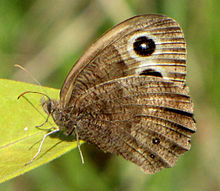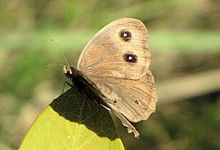- Common Wood-Nymph
-
Common Wood-nymph 
Scientific classification Kingdom: Animalia Phylum: Arthropoda Class: Insecta Order: Lepidoptera Family: Nymphalidae Genus: Cercyonis Species: C. pegala Binomial name Cercyonis pegala
(Fabricius, 1775)The Common Wood-nymph (Cercyonis pegala) is a North American butterfly in the family Nymphalidae. It is also known as the Wood-nymph, Grayling,[1] Blue-eyed Grayling,[2] and the Goggle Eye.[3]
Contents
Description
The Common Wood-nymph can vary greatly. All individuals are brown with two fore wing eyespots, the lower one often being larger than the upper one. Some may have many, few, or no eyespots on the ventral surface of the hind wing. In the southeastern part of its range, it has a large yellow patch on both surfaces of the fore wing. In the western part of its range, it may have a pale yellow patch or may be lacking one. Individuals in the northeastern also lack the yellow patch, i.e., C. p. nephele. In individuals with no yellow patch, there are two pale yellow eye rings that encircle both the fore wing eyespots.[4] The wingspan measures 5.3 to 7.3 cm (2.1 to 2.9 in).[1]
Subspecies
The following subspecies are recognised:
- Cercyonis pegala abbotti (Brown, 1969)
- Cercyonis pegala alope (Fabricius, 1793) – Texas
- Cercyonis pegala ariane (Boisduval, 1852) – Oregon, Utah
- Cercyonis pegala blanca (Emmel & Mattoon, 1972)
- Cercyonis pegala boopis (Behr, 1864) – British Columbia
- Cercyonis pegala damei (Barnes & Benjamin, 1926)
- Cercyonis pegala ino (Hall, 1924) – prairies
- Cercyonis pegala nephele (Kirby, 1837) – northern Canada and US
- Cercyonis pegala olympus (Edwards, 1880)
- Cercyonis pegala pegala (Fabricius, 1775) - eastern US
- Cercyonis pegala stephensi (Wright, 1905)
- Cercyonis pegala texana (Edwards, 1880) – Texas
- Cercyonis pegala wheeleri (Edwards, 1873)
Similar species
In the western part of the Common Wood-nymph's range, there are a couple similar species. The Great Basin Wood-nymph (Cercyonis sthenele) and the Small Wood-nymph (Cercyonis oetus) are smaller, and the lower fore wing eyespot is smaller than the upper one. Mead's Wood-nymph (Cercyonis meadii) has a bright red-orange area on the ventral fore wing.[4]
Range and distribution
The Common Wood-nymph ranges from Nova Scotia and Quebec west to northern British Columbia south to northern California southeast to Texas and east to northern Florida.[4]
Habitat
The Common Wood-nymph is found in a variety of open habitats, such as open woodlands, woodland edges, fields, pastures, wet meadows, prairies, salt marshes, and savannas.[2][5]
Flight period
The Common Wood-nymph is found from mid-May to early October in the eastern part of its range.[2] It is found from late June to early July in California[3] and Arizona.[6] It has 1 brood per year throughout its entire range.[4]
Adult food sources
The Common Wood-nymph feeds on nectar, tree sap, and decaying matters.[2][5] Some of the plants it nectars on include:[5]
- Asclepias tuberosa – Butterfly Weed
- Cirsium arvense – Canada Thistle
- Cirsium vulgare – Bull Thistle
- Daucus carota – Wild Carrot
- Dipsacus sylvestris - Teasel
- Monarda fistulosa – Wild Bergamot
- Pycnanthemum virginianum – Virginia Mountain Mint
- Rudbeckia hirta – Black-eyed Susan
- Trifolium pratense – Red Clover
- Vernonia gigantea – Tall Ironweed
Life cycle
The female Common Wood-nymph is the active flight partner.[1] The female lays her eggs on or near the host plant. The egg is pale yellow, later turning to a tan color with orange or pink blotches. The caterpillar makes no shelters or nests.[3] It is green or yellowish-green with darker green stripes that run the length of the body. It has two short pinkish projections on the end of the abdomen. It has yellow spiracles and is covered in thin, white hairs. The caterpillar will reach a length of 5 cm (2 in). The Common Wood-nymph caterpillar is very similar to satyr caterpillars in the genera Hermeuptychia, Cyllopsis, and Neonympha. It can be separateed by its larger size and habitat.[7] The pale green chrysalis is striped in white or pale yellow. The first instar caterpillar hibernates.[3]
Host plants
Here is a list of host plants used by the Common Wood-nymph:[2][6][7]
- Andropogon sp. – beard grasses
- Danthonia spicata – Poverty Oatgrass
- Poa pratensis – Kentucky Bluegrass
- Schizachyrium sp. – bluestems
- Tridens flavus – Purple top
Image gallery
References
- ^ a b c Shull, Ernest M. (1987). The Butterflies of Indiana. Indiana: Indiana Academy of Science. pp. 227–230. ISBN 0-253-31292-2.
- ^ a b c d e Cech, Rick; Tudor, Guy (2005). Butterflies of the East Coast. Princeton, NJ: Princeton University Press. p. 221. ISBN 0-691-09055-6.
- ^ a b c d Scott, James A. (1986). The Butterflies of North America. Stanford, CA: Stanford University Press. pp. 240–241. ISBN 0-8047-2013-4.
- ^ a b c d Brock, Jim P.; Kaufman, Kenn (2003). Butterflies of North America. New York, NY: Houghton Mifflin. p. 236. ISBN 0-618-15312-6.
- ^ a b c Iftner, David C.; Shuey, John A.; Calhoun, John V. (1992). Butterflies and Skippers of Ohio. Ohio: College of Biological Sciences and The Ohio State University. p. 147. ISBN 0-86727-107-8.
- ^ a b Stewart, Bob; Brodkin, Priscilla; Brodkin, Hank (2001). Butterflies of Arizona. Arcata, CA: West Coast Lady Press. p. 216. ISBN 0-9663072-1-6.
- ^ a b Wagner, David L. (2005). Caterpillars of Eastern North America. Princeton, NJ: Princeton University Press. p. 135. ISBN 0-691-12144-3.
- Darby, Gene (1958). What is a Butterfly. Chicago: Benefic Press. p. 37.
External links
- Opler, Paul A.; Lotts, Kelly and Naberhaus, Thomas (coordinators). "Common Wood Nymph". Butterflies and Moths of North America. http://www.butterfliesandmoths.org/species?l=1857. Retrieved 26 January 2008.
- "Common Wood-Nymph". Canadian Biodiversity Information Facility. 2002. http://www.cbif.gc.ca/spp_pages/butterflies/species/CommonWood-Nymph_e.php. Retrieved 4 September 2009.
Categories:- Cercyonis
- Butterflies of Canada
- Animals described in 1775
Wikimedia Foundation. 2010.






